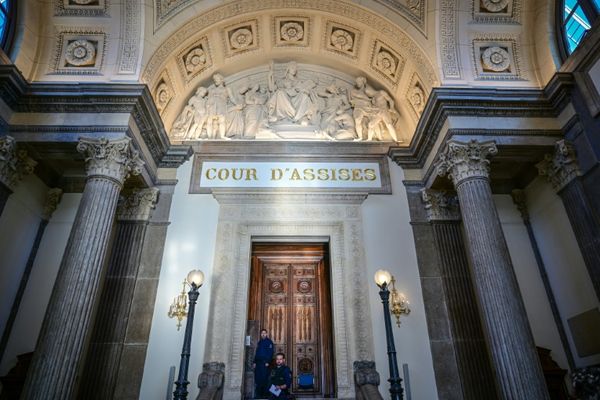Fletcher was born in the Kenyan capital, Nairobi, the son of a civil servant. Back in wartime England, he was sent to Christ's Hospital school, Horsham, Sussex. Drawing was his abiding passion and he attended four art schools: Hammersmith, the Central, the Royal College and the school of architecture and design at Yale.
In 1950, the Central School of Arts and Crafts was a revelation: it was a powerhouse of creativity and experimentation. The principal, the painter William Johnstone, employed the best painters, designers and craftsmen in Britain, all successful practitioners in their fields, providing the school with invaluable contacts in the professional world. Working across disciplines was part of the philosophy and Fletcher had access to such staff members as Paul Hogarth, Victor Pasmore, Keith Vaughan, Richard Hamilton, Eduardo Paolozzi, William Roberts and Mervyn Peake. Fletcher's work at this time was a tentative mix of illustration and painting without much sense of direction.
Jesse Collins, a founder member of design research unit and head of what was then called the department of book production, insisted that all illustration students should acquire a knowledge of typography sufficient to survive in the real world. He then tempted the charismatic typographer/printer Anthony Froshaug to join the staff. Froshaug's rigorous approach - only typescales, layout pads and well-sharpened pencils allowed - attracted a large following. He was the catalyst that changed the thinking of a generation of students, among them Fletcher and his future design partner Colin Forbes. Fellow students included Derek Birdsall, Terence Conran, David Hicks and Peter Firmin. (Another later business partner, Theo Crosby, was studying sculpture at the Central.)
The 1950s in England was a time of food rationing and shortages of all kinds - including paper and art materials. But the spartan atmosphere was conducive to the study of design, which is an essential economy. Creativity and optimism were high, but hard-nosed business was unenlightened if not actually hostile. By this time, however, Fletcher had some idea of the direction that life and work would take him. He had won a place at the Royal College of Art (1953-56), which he took up after a year teaching English at the Barcelona Berlitz. Again, his fellow students proved influential; they included Len Deighton, Denis Bailey, David Gentleman, Dick Smith, Joe Tilson and Peter Blake.
Fletcher's postgraduate year at Yale, with, in contrast to the UK, the prosperity of an economy virtually untouched by war, was - again - revelatory. His tutors included Alvin Eisenman, Norman Ives, Herbert Matter, Bradbury Thompson, ex-Bauhaus figure Joseph Albers ("a bit of a prima donna," according to Fletcher) and the incomparably elegant Paul Rand, who helped him get work and remained an abiding influence.
Fletcher was also blessed with the good luck of being in the right place at the right time. In 1957, while still a student at Yale, he was visiting Fortune magazine in New York just as news of the launch of the Soviet satellite Sputnik came through: a cover was commissioned for first thing Monday morning. It was an incredible coup; students did not usually get Fortune cover commissions. He subsequently worked freelance, encouraged by Saul Bass, Rand and Leo Lionni, eventually working full time for Fortune. He had planned to set up a studio in Venezuela, but a local revolution helped change his mind.The last boat out went to Genoa, and he got a job in the design studio of Pirelli in Milan.
Back in England in 1962, Fletcher and Forbes teamed up with the American Bob Gill to form Fletcher/Forbes/Gill, an archetype of the modern graphic design consultancy. The following year they produced the book Graphic Design: A Visual Comparison, including work by American and British designers. "Our thesis," he wrote, "is that any one visual problem has an infinite number of solutions; that many are valid; that solutions ought to derive from subject matter; that the designer should have no preconceived graphic style."
In 1965, Gill left; Crosby, now an architect, joined; and Crosby/ Fletcher/Forbes set about comprehensive design projects for Shell, and then Reuters. The partnership grew until, in 1972, it changed its name to Pentagram. In 1988 the firm redesigned the Guardian and today it has partners in London, New York, Austin, Texas, and San Francisco, but without Fletcher. He resigned in 1992, after 30 years with the pressures of collective responsibility: "I found myself taking on jobs I would have preferred to avoid. So I thought I'd start over again but confine myself to the work I like." He was essentially a hands-on designer and his return to freelancing gave full rein to his unique style; playing witty graphic games in the spirit of Klee, Miró and Duchamp.
Fletcher had all the medals and citations of establishment man: he was a royal designer for industry (1972), president of the Designers and Art Directors Association (1973), president of the Alliance Graphique Internationale (1982-85), a member of New York Art Directors Club Hall of Fame (1994), a senior fellow of the RCA (1989), an honorary fellow of the London Institute (2000) and more besides. But at heart he remained a maverick, reinstating the idea of the artist in the design process. In life, as in his art, he cut to the chase: reducing options and finding the shortest distance between the idea and the finished article.
In 1993 he became consultant art director to Phaidon Press. His two books, Beware Wet Paint (1996) and The Art of Looking Sideways (2004), were concise demonstrations of his thinking. He was working on numerous projects up to the time of his death. The exhibition Alan Fletcher: 50 Years at Work (and Play) opens on November 11 at London's Design Museum, to coincide with the publication of his book Picturing and Poeting. He owed a lot of his success to the support of his wife, Paola, whom he married in 1956. She survives him, as does their daugher Raffaella.
· Alan Gerard Fletcher, designer, born September 27 1931; died September 21 2006







